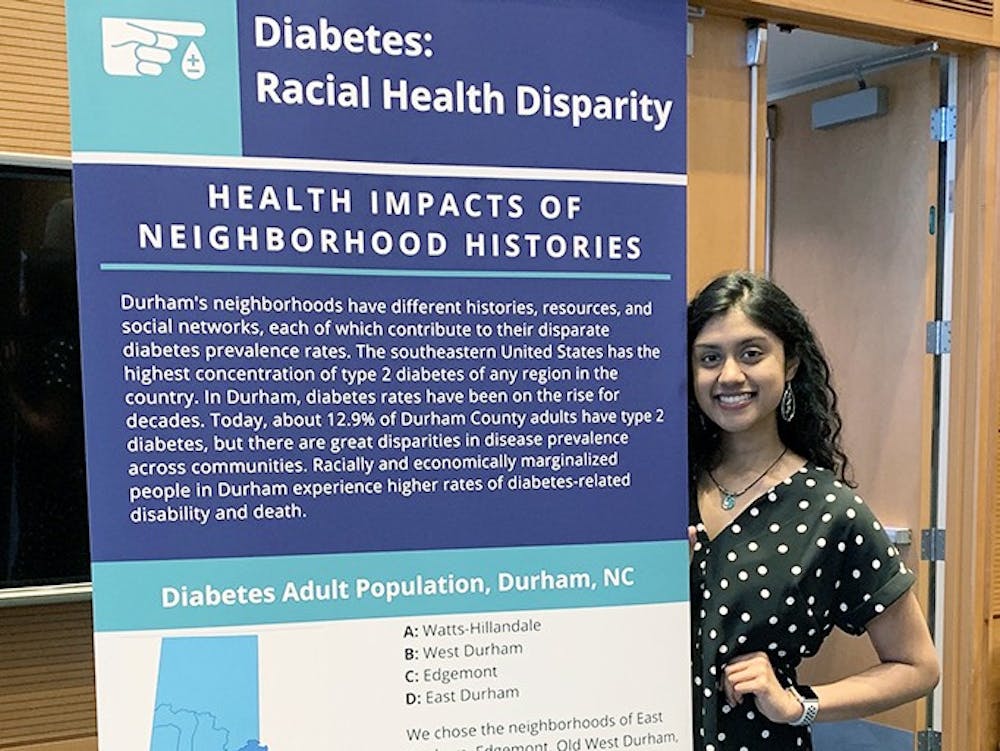In doing justice to Durham’s title of “City of Medicine,” one Bass Connections team is on the right side of history.
After premiering at the Trent Semans Center in April and doing stints at the Durham Health Summit and the Durham County Department of Public Health, the team’s exhibit “Documenting Durham’s Health History” will be on display until Dec. 13 at the Medical Center Library. The exhibit examines the history of local health disparities through four case studies: tuberculosis in the early 20th century, childbirth in the era of hospital desegregation, the HIV epidemic in the 1980s and the current crisis of food deserts and obesity.
Duke has “important responsibilities [to the Durham community],” said Dr. Jeffrey Baker, co-team leader of the Bass Connections project. “We are an important site of healthcare, especially for those who are without privilege. How we treat those folks — that’s a very serious obligation.”
Baker, a practicing pediatrician and medical historian, noted receiving an increase in questions about Durham’s health history in recent years. The existing research to answer those questions, however, was minimal.
Simultaneously, Robert Korstad, a professor of public policy and history and co-team leader of the project, was working on Bull City 150, a public history project that had produced exhibits on Durham’s housing and education inequities. According to Korstad, a project on Durham’s health disparities “seemed like a normal next stage,” considering his many pre-health students interested in health policy.
“I think the experience of doing the project was really beneficial to the students,” Korstad said. “I don’t think they ever thought, ‘Oh, I need to go to the archives, I need to do oral histories.’ I think it challenged them in ways that they probably hadn’t been challenged before in the way they thought about health issues. They had to communicate [these issues] in a way that made sense to people.”
According to Baker, the “vast majority” of current work around health disparities is approached through epidemiological, quantitative studies.
“A lot of it is interesting and provocative work, but I think to really understand how health disparities play out, we have to really … take a deeper dive into individual communities,” Baker said. “It’s not enough just to talk about food deserts. We need to understand … the lived experience of people. Those are not easy things to find through epidemiological approaches.”
In light of this, the team chose to approach their project through humanities, specifically history and documentary storytelling.
“Navigating an extremely complicated healthcare system can be not only incredibly challenging, but disheartening and demoralizing,” wrote Felicity Palma, a graduate of Duke’s MFA in Experimental and Documentary Arts program and graduate advisor on the project, in an e-mail. “I think art ... can give some of that power back to someone who might otherwise feel unheard or unseen … and advocate for patient-centered care.”
Working as a physician, Baker found the project influencing his patient interactions, leading him to ask about their communities. He recalled an interaction with a patient’s grandfather, who was a resident of Durham’s African-American community Hayti during its destruction by the Durham Freeway.
“He looked at me and said, ‘You know, my parents have never recovered from that. They owned a house, they lost the value of the house — they never recovered,’” Baker said. “I thought I had known about the destruction of Hayti … but I don’t think I had thought as much about the long-term ramifications it could leave on families.”
However, according to the exhibit’s creators, the stories told in the exhibit are not tales of Durham’s victimization, but how the community fought back.
“Health disparities are based in these enormous structures that are national and global, but at the same time … oppression happens locally,” said Jessica Hauger, a PhD candidate in the department of history and graduate mentor for the project. “Resistance and activism are things that people have to organize and do, and those things happen on a local scale.”
Increased awareness of that tradition, Baker said, reshaped the project’s focus after the team initially set out to examine how history shows the ways structural racism has shaped disparities.
“Over and over, I was reminded that the community does not want the story to focus on that,” Baker said. “They want just as much attention to focus on how the community has advocated for itself.”
Given the fluid nature of the project, the team hopes to continue engaging further in the Durham community and telling more stories.
“Whenever [we] set up the exhibit in another location, people will say, ‘You left us out of the story!’ — and that’s terrific,” Baker said. “[We’re] hoping to highlight awareness of the importance of story, and the importance of history. We understand that inequities today … are the product of past policies and past decisions. I think that makes us understand that we can change them as well.”
Get The Chronicle straight to your inbox
Signup for our weekly newsletter. Cancel at any time.

